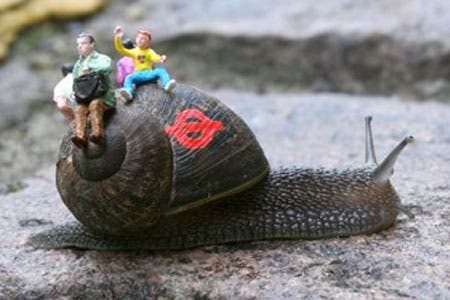
For the casual nature enthusiasts, snails are a infinite source of joy whenever people come across them. People like to study them and revere how beautiful they are in their own microcosmos – for a while at least, until they get bored that is; it’s a slow paced microcosmos after all. For others, snails are nothing more than pests; slimy critters who wreck havoc in gardens. Instead of using chemicals or messy beer traps, like some gardeners employ, it’s better maybe to simply throw away the snails out of your backyard. A new research found that a safe distance for moving snails so they lose their homing instinct and can’t naturally return to the original spot you found them is about 20 meters. No snails were hurt during the course of this study.
The snail wars…
A famous experiment from 2010 proved that snails have a homing instinct over short distances, returning to their original spots. While this is true, according to researchers at Queen Mary, University of London and the University of Exeter this homing instinct can be overcome for many snail populations. If the pests are removed by at least 20 meters from their home patch, they will largely be unlikely to return.
[ALSO READ] Snail venom inspires powerful pain reliever without any addiction
Does this mean we can expect hundreds of hurling snails tugged from one garden to another by bothered neighbors? Might be the case for a while if the right people read this article, but even if you manage to remove a large proportion of the blighters, they are likely to repopulate your herbaceous borders alarmingly quickly. This is because there are two distinct populations of snails: the kind who show little affinity to the garden itself (these comprise the bulk of snails) and the kind who stick to the local garden exclusively and regularly return to their home if removed. It’s the latter the can be thrown away never to come back.
[MORE] Getting across: how snail travel through birds’ bellies
The 20 meter margin was chosen after researchers marked snails with correction fluid and checked the plants to see whether they returned if lobbed away. Then statistical analysis of the empirical data showed that removing snails by distances of more than 20 metres is usually sufficient to nullify their homing instinct.
David Dunstan, professor at Queen Mary University of London and co-author of the research study published in the journal Physica Scripta, said: “We showed that the number of snails regularly or irregularly visiting a garden is many times greater than the number actually present at any one time in the garden. As such, gardeners shouldn’t be setting out to eliminate snails from their gardens. To achieve such a feat would require the gardener to rid the whole neighbourhood of snails, which would be a slow process. Gardeners should be setting out to minimise the damage done by snails, which our results showed could be quickly achieved by simply removing the snails over 20 metres away.”
Was this helpful?



